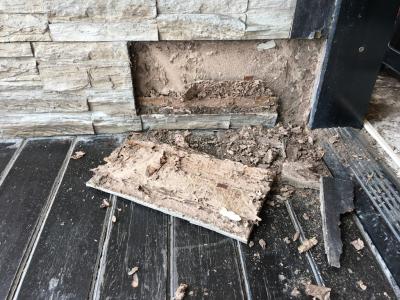
10 Fascinating Facts About Termites versus Carpenter Ants
Nobody wants to learn that termites or carpenter ants have taken up residency in their home. However, it’s always better to be alert to signs of problems, including potential insect infestations. The following facts can help you spot trouble and implement quick countermeasures!
Termites
1. Termites are messy.
When termites attack a home, they make a sloppy mess of things. Often, you will see damaged wood covered in mud, discarded wings, insect body parts, and frass – an unsavory mixture of saliva, feces, and wood. They nest underground and consider your home an endless buffet.
2. Termites eat from the inside out.
Termites can digest wood, paper products, and anything with cellulose. Since they eat from the inside out, a wood plank might sound hollow when you tap it or collapse when struck. Likewise, when termites eat painted wood, the paint on the surface may appear uneven or bubbled.
3. Some termites create audible sounds.
Termites live in colonies that operate under a three-part caste system—soldiers, workers, and reproductives. The soldier and worker termites are sterile and can be male or female. Soldiers are in charge of defending the colony and will bang their heads against the wood to alert others when they sense danger. So if you hear a quiet “clicking” behind your walls, it may be a sign of infestation.
4. Termites can remain active in winter.
Cold weather can drive termites into hibernation, but only if they are living outside and vulnerable to freezing temperatures. If they establish a colony inside your home before things get cold out, they can have access to wood, water, and warmth and will continue to thrive in their winter getaway.
Carpenter Ants
5. Carpenter ants don’t “eat” wood.
Unlike termites, carpenter ants only burrow into wood to make nests, tunnels, and shelter. Instead, they dine on other foodstuffs, like sweets, meat, and pet food.
6. Carpenter ants prefer moist, rotting, and softer wood.
It’s easier for carpenter ants to burrow through softer wood, leaving a tidy pile of sawdust outside. If they can’t find the damp wood they prefer, they may use foam insulation for the same purposes. They may also nest inside hollow doors.
7. You are more likely to spot carpenter ants at night.
Nocturnal by nature, carpenter ants attack your home while you sleep. After the sun sets, you may notice them on a path from their nests to a nearby food source in your home.
8. Carpenter ants are also sensitive to cold weather.
Like termites and other insects, carpenter ants are cold-blooded and can die from exposure to freezing temps. But they respond well to cooler temperatures and are often more active in the fall, potentially using this time to take up residence in your home!
Swarms
9. Both termites and carpenter ants “swarm.”
When a colony becomes large enough, both species will sprout wings and take to the air to establish new nests. Carpenter ants tend to do this at night, whereas you may observe a termite swarm during daylight. Both types of swarmers will drop their wings during the swarming and mating process, so piles of discarded wings are a sign of a new infestation.
Get Professional Help
10. Don’t procrastinate!
Regardless of which type of pests you think you have, you will probably need professional help to eliminate them. Often, by the time you discover you have a problem, the damage has already occurred. If ignored, these pests will continue to burrow or eat their way into your home.
